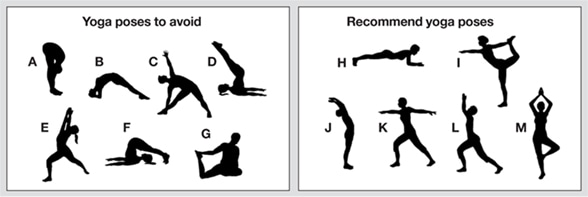Sept. 15, 2018
Yoga has gained increased popularity for the promotion of both mental and physical health. A 2012 national survey found that approximately 10 percent of U.S. adults (21 million) practiced yoga. Matthew T. Drake, M.D., Ph.D., with Endocrinology, Diabetes, Metabolism, and Nutrition at Mayo Clinic's campus in Rochester, Minnesota, says: "Importantly, yoga has found significant traction among more older adults, with a recent report that more than 20 percent of U.S. yoga practitioners are older than 60 years, perhaps in part due to reports that the regular performance of yoga has the potential to improve balance and to limit falls.
"The relative safety of yoga in at-risk populations, however, remains largely undetermined. Thus, between 2001 and 2014, nearly 30,000 visits to U.S. emergency rooms were related to yoga-associated injuries, with 13 percent of injuries occurring in those age 65 years or older. Further, injury rates in the older adults increased from 6.9 to 57.9 per 100,000 participants over this same time frame.
"However, it has been difficult to estimate and characterize the yoga-specific associated risks, define the at-risk populations for yoga-associated injuries, and identify potential protective measures to limit injuries."
Mehrsheed Sinaki, M.D., M.S., with Physical Medicine and Rehabilitation at Mayo Clinic's campus in Minnesota, comments: "Whether the effects of yoga on the skeleton are beneficial or harmful remains a subject of debate. While a recent report suggested that daily yoga exercises may increase bone mineral density over two years, it was not clear that fracture risk was diminished. Further, a recent systematic review identified the musculoskeletal system as the most common site of yoga-associated injuries.
"Given both that many yoga exercises involve significant spinal flexion, extension and torsion and that many yoga adherents are aged and thus likely to be at increased fracture risk, it is of potential concern that some yoga exercises may surpass the biomechanical competence of the spine and result in vertebral compression fractures (VCFs)."
Jad Sfeir, M.D., with Endocrinology, Diabetes, Metabolism, and Nutrition at Mayo Clinic's campus in Minnesota, explains: "To address this concern, we recently published a study in the European Journal of Physical Rehabilitation Medicine where we evaluated 33 consecutive patients with back pain that began after yoga exercise. Plain radiographs and medical records were reviewed to ascertain the relationship between the development of acute pain with associated VCFs and the yoga exercise. Nine patients met all criteria. All patients described a yoga-associated spinal flexion exercise as causative of the acute back pain that preceded their VCF diagnoses.
"Consistent with the increased popularity of yoga in the general population, six of the nine people had initiated yoga without a medical recommendation. Collectively, the group included eight women and one man. Median age was 66 years (range, 53 to 87 years), and eight people were Caucasian. The primary basis for presentation in all people was back pain, which ranged from four to 48 months in duration. VCF occurred one to 72 months after yoga exercise initiation, with four patients having fractures within one year of starting yoga. VCFs were identified in the thoracic (n = 6), lumbar (n = 4) and cervical (n = 1) spine.
"Dual energy X-ray absorptiometry (DXA) assessment performed at a median of 10.5 months prior to the index VCF showed that only four patients had osteoporosis by bone mineral density criteria, while one additional patient was classified as having osteoporosis due to a history of a prior fragility fracture. In only one patient was a secondary cause (primary hyperparathyroidism) for osteoporosis identified. Notably, four patients sustained a VCF in the setting of normal or near-normal bone mineral density."
Dr. Sinaki highlights: "Spinal flexion exercises are common in yoga and produce increases in both torque pressures and compressive mechanical loading forces applied to individual vertebral bodies. These forces may be additive or multiplicative and result from a diminished ability of the intervertebral disks to absorb the simultaneous combination of forces from upper body weight, spinal flexure muscle contraction and spinal longitudinal ligament strain.
"Importantly, these issues may be particularly acute in older people, in whom age-associated degenerative changes in the intervertebral disks are common. While there is good evidence that appropriate exercise and rehabilitation programs can significantly reduce fracture risk, the incorporation of safe exercise practices is essential for balancing progressive skeletal loading activities within biomechanical limits. Accordingly, the implementation of personalized exercise programs, ideally aimed at strengthening both the back extensor and core abdominal muscles to increase overall balance and stability while simultaneously avoiding excess spinal strain, becomes crucial.
Recommended yoga poses and poses to avoid

Recommended yoga poses and poses to avoid
A-G. Yoga poses that generally should be avoided in at-risk patients given the extreme flexion, extension and torsional strains involved. H-M. Yoga poses that will increase balance and muscle strengthening without imposing significant spinal forces. Based on European Journal of Physical and Rehabilitation Medicine.
"The figure demonstrates yoga poses that generally should be avoided in at-risk patients given the extreme flexion, extension and torsional strains involved. Also included in the figure are yoga poses that will increase balance and muscle strengthening without imposing significant spinal forces."
Dr. Drake concludes: "In sum, yoga has unfortunately been misconceived as a one-size-fits-all prescription based on scientific and media reports that continue to advertise yoga as a purely bone protective activity. Instead, the cornerstone for fracture prevention and benefit from yoga should be the appropriate selection of patients and provision of an appropriate yoga poses prescription."
For more information
Sfeir JG, et al. Vertebral compression fractures associated with yoga: A case series. European Journal of Physical and Rehabilitation Medicine. In press.